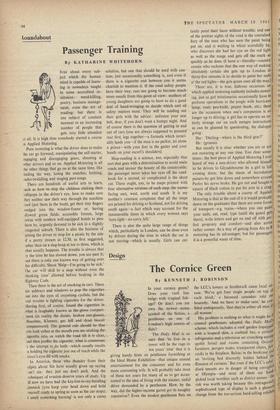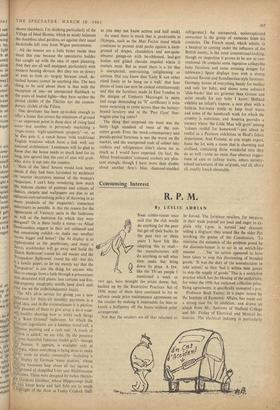Design
The Cornice Green
By KENNETH
J. ROBINSON
Is your cornice green? Does your roof line bulge with tropical foli- age? Or don't you yet own the newest status symbol of the Sixties, a penthouse on one of London's high towers of flats?
The Daily Mail is so sure that `to live in a tower will be the rage in ten years' time' that it is giving handy hints on penthouse furnishing at the Ideal Home Exhibition—that unique annual entertainment for the consumer and his even more consuming wife. It will probably take most of those ten years for many of us to get accus- tomed to the idea of living with the sinister, sinful decor demanded by a penthouse. How, by the way, did the higher-income garret get its naughty reputation? Even the modest penthouse flats on the LCC's towers at Southwark cause local urr ease. 'We've got four single people on top cf . each. block,' a harassed caretaker told Iv hoarsely. 'And we have to make. sure,' he cor fided ambiguously, 'that they're either all men 0 all women.' His problem is nothing to what it might be If council penthouses adopted the Daily Mails scheme, which includes a roof garden (equipped with a leopard skin, a cocktail bar, a crimson refrigerator-and a television set crouching among spotlit ferns) and rooms containing Orienttl furniture, perspex nudes, transparent chairs. Pee' cocks in the fireplace, Balzac in the bookcase and an 'inviting bed discreetly hidden behind the flimsiest of curtains.' But even if the LCC's subs" dised tenants are in danger of being corrupts at Olympia—and most of them are hand' picked local worthies such as district nurses—the risk was worth taking because this outrageouslY sophisticated type of display is such a pleasant change from the too-serious hard-selling exhibilt5
THE SPECTATOR, MARCH 10 U96 shown elsewhere. I'm thinking particularly of the Village of Ideal Homes, which so nicely balances the doubtless ideal gardens, set against their usual backcloths left over from Wigan pantomimes.
All the houses are a little better inside than usual this year because the speculative builder has caught up with the idea of open planning. And they are all well equipped, particularly with modern heating devices. But they are as dreary as ever to look at—largely because small, de- tached houses cannot be anything else. The best thing to be said about them is that with the exception of one—an unexpected flashback to the years of leaded lights—they have neither the period cliches of the Thirties nor the contem- porary clichés of the Fifties.
One developer has been up-to-date enough to ,offer a house that covers the minimum of ground .'-an important point in these days of rising land costs—but another is perversely marketing a single-storey 'eight-apartment property'—or, as he also puts it, a ranch house 'with traditional English windows which form a link with our national architecture.' Londoners will be glad to know that the house needs so much land for its long, low sprawl that the cost of sites will prob- ably drive it out into the country.
1. Most of the 'ideal' houses would look better inside if they had been furnished by architects Or interior decorators instead of the women's magazines. I can't help wondering how much the hideous clashes of patterns and colours of fabrics, carpets and wallpapers are due to an editorial-cum-advertising policy of throwing in as Many products of the magazine's staunchest advertisers as possible. Is this the reason for the appearance of Vanitory units in the bathroom as well as the bedroom for which they were 'designed? Or is there really a move—as Allied II-confounders suggest in their not unbiased' and Ain unamusing exhibit—to make our smallest rooms bigger and better? The Al display is as sophisticated as the penthouses, and many a Surrey stockbroker will go away and build the butch Bathroom' round his old master and the .Pompadour Bathroom' round his old—but this i‘s a family paper, so let me merely say that the Pompadour' is just the thing for anyone who likes to emerge from a bath through a proscenium arch decorated with plastic lace curtains and five- and-sixpenny anaglyptic motifs (and don't stub Your toe on the unBritishdammit bidet).
The Al's all-in service for giving you a new .b.athroom for thirty-six monthly payments is a rapci idea, and in the circumstances it is particu- rlY pleasant of them to give away a do-it-your- set, booklet showing how to make such things 43 A 'Kent Oriental' bathroom, for which the , j Principal ingredients arc a bamboo towel rail, a "PP0 Phnese painting and a rush mat. 'A touch of usion is added,' we are told, 'by the presence 4„1 or oO. mc beautiful Japanese model girls'--though 0 feature, it appears, is available only at LitYlnpia, where everything is being done to make a- Vi tile jltir seem an exotic commodity-- including a subsi' -.display by German 'water pianists,' whose A iing fountains leap about all day against a rupte; ,,round of sloppified Liszt and Aladdincsque s_the ,pactites. These were designed by James (Batter- oust)! easarl( xhibit5 ,Gardens) Gardner, whose 1-lippocampi (half Jfl You know horse and half fish) arc as much h!ghlight of the show as Fanny Cradock (half as you may not know actress and half cook).
As usual there is much that is predictable at Olympia, such as the Max Factor stand which continues to present mud packs against a back- ground of drapes, chandeliers and not-quite- obscene goings-on with be-ribboned, leaf-girt bodies and gilded cherubs impaled where it matters most. But as usual there is a lot that i3 unexpected, entertaining, enlightening or curious. Did you know that 'Lady K can either stand freely or be hung on a wall,' that four pieces of toast can now be cooked simultaneously and that the furniture made in East London to the designs of Umberto Macscagni (a name and range demanding an 'X' certificate) is even more surprising to come across than the battery- heated lavatory seat or the `Peer Gynt' Nor- wegian pine log cabin?
The thing that surprised me most was the fairly high standard of most of the con- sumer goods. Even the mock-contemporary and pseudo-period furniture is not the worst on the market, and the unexpected rush of colour into cookers and refrigerators didn't alarm me as much as I would have expected. (In fact, the Allied Ironfounders' coloured cookers are plea- sant enough, though I have more than doubts about another firm's blue, diamond-studded refrigerator.) An unexpected, undercaptioned newcomer is the group of nurseries from six countries. The French stand, which admits in a handout to coming under the influence of the British nanny, is the most conventional-looking, though on inspection it proves to be not so con- ventional. (It contains some ingenious collapsible baby furniture and some amusing designs for tableware.) Spain displays toys with a strong national flavour and Scandinavian-style furniture. Germany boasts of everything handy for mother and safe for baby, and shows some coloured `slide-books' that are grimmer than Grimm and quite unsafe for any baby I know; Holland exhibits an infant's trapeze, a neat plate with a built-in hot-water bottle to keep food warm and some of the handicraft work for which the country is notorious; and America provides a nursery where `the Little Man will grow' among `colours restful for homework'—just about as restful as a Pasmore exhibition in Heal's fabric department. And Finland, as you might expect, beats the lot with a room that is charming and civilised, containing those wonderful toys they do so well—some no more than abstract sugges- tions of cars or railway trains, others nursery- school caricatures of the originals, and all, above all, readily knock-aboutable.







































 Previous page
Previous page